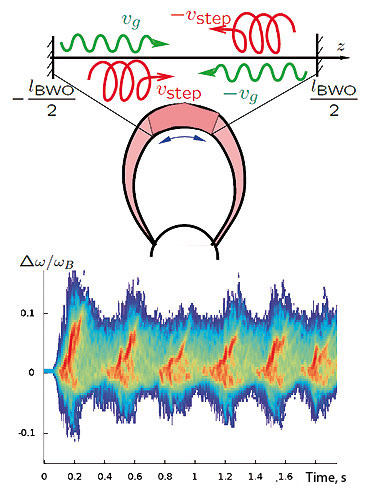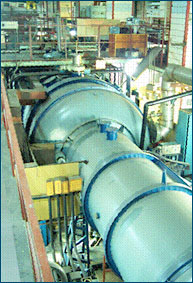An important object of theoretical studies is plasma processes in the ionosphere and magnetosphere of the Earth and other planets (including exoplanets), in particular, generation of electromagnetic radiation and its action on thermal plasma and energetic charged particles, formation of plasma flows in planetary magnetospheres, etc. (V. Yu. Trakhtengertz,
P. A. Bespalov, Yu. V. Chugunov, V. E. Shaposhnikov, Vl. V. Kocharovsky, A. G. Demekhov, V. M. Gubchenko,
S. S. Davydenko). In recent years, many original results have been obtained in these fields, specifically:
- the theory of VLF chorus emissions in the magnetosphere of the Earth and planets has been developed and used to create the numerical model, which explains the main features of the dynamic spectra of chorus signals registered in space experiments. The results of the theory have been correlated with the observation data;
- operation of the magnetospheric cyclotron maser in the regime of passive mode synchronization has been modeled. This model has been correlated with the up-to-date experimental data provided by satellite-borne and ground-based experiments. The origin of short-period VLF emissions with second-long periods of repetition of spectral forms has been explained quantitatively;
- the theory of global synchronization of the operation of the magnetospheric cyclotron maser has been developed, which explains the clock effect in the Jovian radiation belts. The deep spatial synchronized oscillations in the level of whistler electromagnetic radiation, which were predicted theoretically, have been found in later space experiments;
- the theory of high-efficiency mechanism of electron acceleration up to energies of about several MeV in the Earth's radiation belts due to the discrete spectrum of electromagnetic whistler radiation has been developed;
- the theory of the origin of the high-power UV radiation observed in the limb of Io, one of Jupiter's moons, near its equator has been developed;
- an original mechanism of formation of narrow-band emissions and quasi-periodic sequences of pulses of Jovian decameter radio emission has been proposed. The mechanism is based on the effect of changes in the amplitude-frequency characteristics of radiation during its propagation through a region with a nonstationary perturbation of medium parameters;
- a wide class of plane-stratified stationary current configurations (current sheaths), which correspond to the localized current (including the case of n external magnetic field present) and allow for different current density profiles and arbitrary functions of particles' energy distribution, including relativistic ones, has been found analytically using invariants of the particle motion, which make it possible to solve exactly the system of nonlinear kinetic equations and Maxwell's equations;
- the electromagnetic Q-factor of the plasma has been found from the solution of the self-consistent kinetic problem about a flow of hot collisionless anisotropic high-pressure plasma around magnetized bodies. This factor is calculated on the basis of the form of the particle distribution function and determines the topology of large-scale electromagnetic structures similar to the magnetosphere;
- the earlier model of the planetary electric generator has been developed further with allowance for the radial inhomogeneity of the rotational speed of the conducting planetary sheath; formation of plasmospheres of rotating magnetized planets, plasma flows in the magnetosphere, and current structures, connected with the effects of unipolar inductance, has been studied;
- the Wiedemann — Franz law has been generalized for the plasma with ion-sonic turbulence, which develops in the absence of particle flows, but in the presence of the temperature gradient of different plasma components;
- formation of a strong plasma turbulence in the field of a kinetic Alfvén wave propagating almost transversely to the external magnetic field in the rarefied plasma of the auroral magnetosphere has been studied; specifically, peculiarities of formation of density caverns with a nonstationary electric field have been found, which are connected with the formation regularities of suprathermal electrons and protons.
IAP RAS has become one of the initiators and authors of the scientific program of the "Resonance" project, which encompasses satellite-based studies of plasma phenomena in the internal and auroral magnetosphere of the Earth and is included in the framework of the RF Federal Space Program for realization in 2014.
 |
Scheme of cyclotron magnetospheric maser and a typical dynamic spectrum of the corresponding short-period
VLF emissions
|
The following main lines of near-space research at IAP RAS remain relevant to this day:
- development of advanced theoretical models to explain quantitatively multiple experimental data about the dynamics of flows of energetic charged particles in the Earth's magnetosphere and the spectral structure of the electromagnetic signals that accompany these precipitations;
- development of new theoretical models that allow one to use one common approach to the description of generation of discrete and noise electromagnetic emissions;
- studies of acceleration of charged particles in radiation belts and the auroral magnetosphere of the Earth by the natural field with the discrete and noise electromagnetic spectra;
- studies of three-dimensional current systems that are formed during precipitation of energetic particles;
- application of the theory of magnetospheric masers to explanation of many processes in the solar corona and planetary magnetospheres;
- development of theoretical concepts of the transfer of energy and momentum in the "atmosphere-ionosphere-magnetosphere" system.
 |
Electrodynamic line for transportation
of the "Krot" stand radiation
|
An important part of space plasma studies are laboratory experiments performed to simulate the corresponding phenomena and processes. Two facilities are used in these experiments at IAP, specifically, the "Krot" large-scale plasma chamber and the SMIS-37 setup. The latter is based on a mirror magnetic trap with the plasma created and maintained by high-power microwave radiation under the conditions of electron cyclotron resonance, which contains, along with the quasi-equilibrium electron component, a small fraction of energetic electrons with an anisotropic velocity distribution. In the experiments performed on this setup, two types of quasi-periodic precipitations of energetic electrons, which are due to nonstationary regimes of cyclotron instability evolution, have been discovered and are studied now (A. G. Demekhov, S. V. Golubev, D. A. Mansfeld, A. G. Shalashov). One of these regimes is realized in sufficiently dense plasma at the stage of microwave pumping and is due to excitation of whistler waves, which propagate quasi-longidutinally with respect to the magnetic field under the conditions being close to those of the Earth's internal magnetosphere in terms of their dimensionless parameters. The other regime is formed in decaying plasma, where the effect of cyclotron radiation depression transversely to the external magnetic field disappears due to a decrease in the plasma density, and the conditions in the laboratory setup become close to the rarefied plasma of the auroral magnetosphere in the region of generation of the auroral kilometer radiation.
The unique large-scale plasma stand "Krot (Mole)" is used in various experimental studies of the fundamental and applied nature. The fundamental problems include studies of physical processes, which develop during excitation and propagation of intense electromagnetic radiation and its interaction with magnetized plasma, including parametric phenomena, the effects of generation of direct currents and magnetic fields, and formation of self-consistent plasma-field structures. The applied studies performed at the stand are simulation of the influence of the near-Earth plasma on operation of antennas borne by geophysical spacecraft and active plasma-wave experiments in near space including the "Resonance" international project.
|
|
Effect of the amplitude-frequency modulation (a—c and d–f) of an initially continuous and unmodulated signal after its transmission through plasma with low-frequency perturbations of the magnetic field. Model experiment on the "Krot" stand
|
Example of the dynamic spectrum of the Jovian decameter radiation, whose frequency-time features result from the amplitude-frequency modulations of the signal when it propagates through the region with quasiperiodic perturbations of the Jovian magnetic field in the planet's atmosphere.
|
A strong amplitude-frequency modulation of the radiation, which had been continuous initially, was observed in a model laboratory experiment, where electromagnetic radiation propagated through magnetized plasma with quasiperiodic perturbations of the magnetic field at a level of up to several percent. Then, isolated compressed wave pulses with a drift of the carrier frequency were formed. Nowadays, this effect, which was discovered experimentally on the "Krot" stand, is used to explain the effects that take place during the formation of the fine structure in the dynamic radio emission spectrum in the magnetospheres of the Earth and Jupiter.





